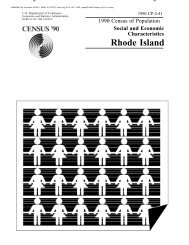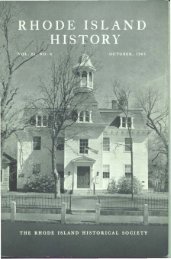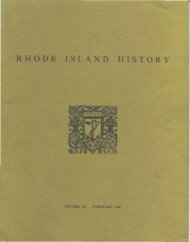RHODE ISLAND HISTORY - Rhode Island Historical Society
RHODE ISLAND HISTORY - Rhode Island Historical Society
RHODE ISLAND HISTORY - Rhode Island Historical Society
- No tags were found...
You also want an ePaper? Increase the reach of your titles
YUMPU automatically turns print PDFs into web optimized ePapers that Google loves.
53 PROVIDENCE VISITORcared. Althou gh liberal Ameri cans wer e not condemned.the princi ples of those European libe ralswh o had built upon the Americans' ideas - theseEuropeans. significantly, called their program"l'Americanisme" - wer e declared heretical. T hecondemna tion was a clear signal to American liberalsto temper their views on coexistence wit hP rotesta nts: this they indeed did All that remainedof the liberal movement was the propensityto appeal to nationalistic impulses of AmericanCatholics: it was a way both to protect and to promotethe church. Cardinal Gibbons said in 1917:"The primary duty o f a citizen is loyalty to country."His statement best summarized the patrioticand conservative stance adopted by the church beforethe coming of the Great War.'Int ellect ual battles meant little had not theviews of the church hierarchy been widely publicizedamong the American faithful. The bishops.in keeping with the need to publicize the church 'spositions on many issues, had urged establishmentof a strong and outspoken Catholic presssince the 1880s. Fear of Protestant-oriented•• 'Sunday papers: which often attack fait h andmorals," led bishops to promote diocesan newspapers."but one paper for each Province," By 1911.when the Catho lic P ress Assoc iation was founded,this goal had been largely reached. When nativismreemerged with such great force in 1916, a vigorousCatholic press was ready to ed itorialize indefe nse of th e ch urch and its faithful. F ounded in1873, the Providence Visitor was typi cal of theCatholic press, both in the nature of the diocese itserved and in the fact that its editor, Edward 1Cooney, became first president of the CatholicPress Association, placin g the Visitor in the mainstreamof both Ca th olic life and of the press establishmentof the church.'Providence's diocese - actually encompass ingthe state of <strong>Rhode</strong> <strong>Island</strong> - had many characteristicstypical of other urban dioceses of the 1910sand 19208. It ministered to large numbers of foreign-bornpersons, many from Catholic countries.In 1910, the diocese and sta te had 178,025 personsof foreign birth residing within their borders: despitenatural attrition and sharply reduced immigrationduring the war, 173,499 residents bornabroad were listed in 1920. In 1910. the largest ofthe traditionally Catholic groups were, in order ofsize: French-Canadians. Irish . Italians, Poles, andP ortuguese. By 1920 Italians were the most numerousgroup among the foreign born. T o thesefigures must be added la rge num bers of second and third-gen er at ion Am ericans who retainedst rong ties to their ancestral ho melands.sDes pit e the sheer nu mbers of F rench-Canadiansand Italians in the diocese, the Visitor an d thechurch hierarchy remained Irish-dominated.Throughout the period. the Visiror ea gerly followedreports of Irish bravery in the British expeditionaryforce on the battlefields of Fran ce, the1916 Easter R ising in Dublin, and establishmentof the Irish Free State. Early in 1920 the Visitorsummarized its view of the Irish question: "Therewill be no permanent peace until Ir eland's claimsare satisfied. Not so much because four millions ofpeople are denied the right of self-government,but rather because Ireland's cause is the cause offreedom." The Visirortook a sour view of th eLea gue of Nations after it appeared that theTreaty of Verg,illes would not establish Irish independence.Its editorials and news items revealedan orthodox Iri sh pa per,Despite its Irish bias, the pa per occasionallybowed to other ethnic groups; T he growing powerof Ita lians, es pecially during the 1920s, warrantedmention. T he Visitor corr ectly linked the newestimmigration restriction bill with nativist enmityagainst Italians, concludin g: "We have felt thefor ce that wou ld drive from us the spiritual values,and so we enact a law against the It alian inwhom resides the high culture of Christian civilization."Occasional news items touched uponchurch activities, especially in war relief in Polandand other eastern European nations. Buteven the P oles, a sizeable group. received onlyone mention, in a column commending the immigrationbureau for refusing to deport two Polishgirls,OCuriously, French-Canadians received no editorialmention in the Visirorduring this period. Despitethe size of the French-Canadian community,only items of a social nature appeared in local colummunder Woonsocket parish activities. TheFrench-speaking community did, however, haveits own papers- including the important La Tribune.Perhaps the sense of being a separate. albeitdevoutly Catholic entity - as Jacques Ducbarme.a French-Canadian writer, has suggested-c-explains their absence from the pages of











